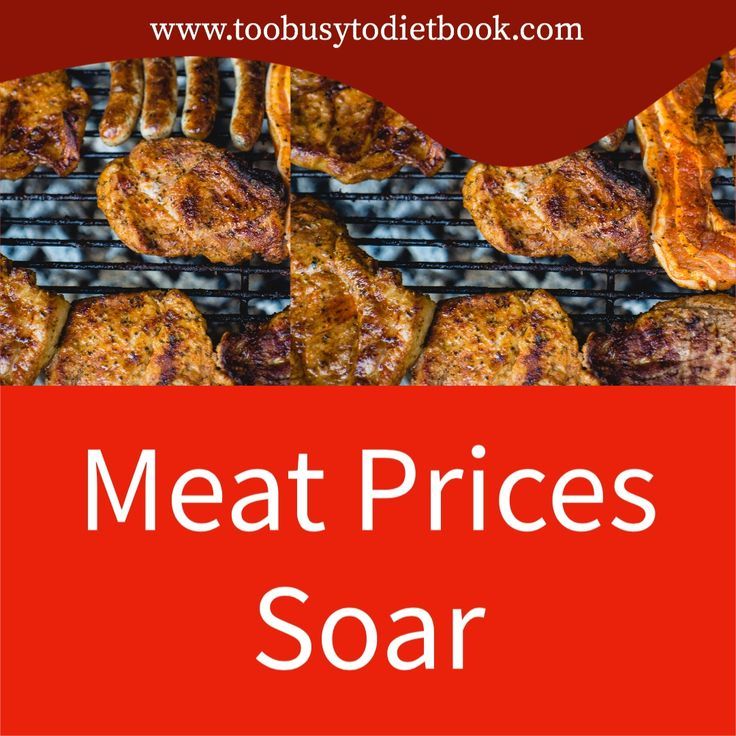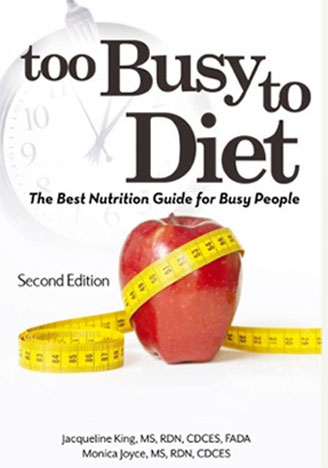Meat Prices Soar
in The Too Busy to Diet Blog on November 22, 2021

Prices of Meat are Increasing… How Can We Get Enough Protein Without the Cost?
The food system is feeling the effects of the global pandemic with shortages of workers and food products causing transportation and supply issues. As a result, many of the groceries we buy are in high demand with short supply and meat prices are on the rise. If you are one who gets most of your protein from meat, it may be time to consider new options.
Here are some ideas:
- Trade beef for chicken and pork products.
- Buy store-brand meats.
- Opt for bone-in meats.
- Buy ground beef instead of cuts.
- Monday is a good day to get marked down meat packages on meats approaching their expiration dates. Butchers cut more meat on weekends due to the increased numbers of shoppers leading to extra meat on Mondays.
- Keep an eye on price per pound and look for sales at your favorite stores for favorite cuts.
- Watch for sales before holidays and stock up for meals after the holidays.
- Buy meat in bulk and divide packages at home to take advantage of the lower price per pound.
- Two stores to look to for lower meat prices are Costco and Aldi. Aldi offers lower prices on other grocery items as well so take advantage of their weekly specials.
10. Chicken provides the cheapest cuts of meat. Try buying chicken thighs, wings, and whole chickens that can be purchased cheaper and cooked in crock pots for cheaper and easier meals.
11. Buy sirloin in place of T-bones and spare ribs in place of baby back ribs.
12. Buy pork loins on sale and slice into boneless pork chops at home.
13. Eggs are a cheap protein source that can be used for any meal. Although egg prices have increased, stores have used egg sales to get customers in the store to take advantage of egg sales and purchase of other more expensive food items. For those needing to watch cholesterol, use one whole egg and one egg white to reduce cholesterol content while increasing protein intake. Make scrambled eggs, omelets, egg casseroles, and quiches that are more economical sources of protein.
And if this is still not helping to bring down costs, consider adding plant-based protein to your diet or trending towards eating more like a vegetarian. Even though meats are some of the best sources of protein, getting enough protein as a vegetarian is still achievable.
Following are some important aspects of plant-based proteins and how to get the most out of these options while saving some money in the process!
Why do vegetarians need protein from plants? It is important for the structure and function of:
- DNA (genetic material)
- cells
- nerves
- hair
- skin
- muscles
Recommended daily protein levels for vegans:
Men = 56-70 grams/day
Women = 46-58 grams/day
Complete proteins:
In order for a protein to be considered complete, it must contain all nine of the essential amino acids, the building blocks that the human body cannot make on its own. Meat, dairy, and eggs are complete proteins, but if a vegetarian diet is lacking one or more of these foods, then the daily protein requirement may be hard to meet. Luckily, there are two plant foods that each contain all of the essential amino acids.
1. SOY
The main source of complete plant-based protein. It is similar in quality to the protein in eggs and meat.
2. QUINOA
A grain that offers complete protein. It is high in complex carbohydrate, calcium, and potassium.
Incomplete proteins:
These proteins are missing, or may have limited amounts of, at least one of the nine essential amino acids. Eating a variety of plant foods with incomplete proteins throughout the day can help in getting a good supply of all of the essential amino acids.
Or, combine foods from the following categories to get complete protein at each meal:
Whole grain breads & Non-dairy milk with casein Legumes – beans, lentils, or peanuts & rice
The following are examples of incomplete proteins to include in a daily vegetarian diet:
- Nuts
- Average 4-6 grams protein per 1 ounce serving to provide satiety, plus they contain heart-healthy fats, fiber, vitamins/minerals, and antioxidants.
- Seeds
- Provide protein, fiber, unsaturated fats, vitamins/minerals, and phytonutrients, which have possible health benefits like helping the body fight certain diseases.
- Dark leafy greens
- Average 4-5 grams protein in 1 cup, plus vitamin C, beta-carotene (pro-vitamin that helps the body make vitamin A), potassium, folate, calcium, and magnesium to help reduce risk of chronic diseases.
- Tempeh
- Provides 17g protein in ½ cup, plus fiber, iron, and B vitamins for metabolic processes.
- Tofu or bean curd
- Provides 9g protein in ½ cup, and it’s often calcium-fortified for bone health, blood clotting, and muscle contractions.
- Legumes (beans and peas)
- Good source of protein and they provide fiber and other micronutrients like iron to carry oxygen in red blood cells, and zinc for body functions, immunity, and growth.
- Peanut butter
- 2 Tbsp = 8 g protein, which is a good amount of protein to pair with other foods to help achieve the minimum recommended daily amount.
- Bagel
- 9 grams protein in a medium-size portion can be used as a source of protein for adding up to the daily recommended amount.
- Spaghetti
- 1 cup = 8 grams protein, which can also be paired or used to achieve the minimum daily recommendation.
With all of the plant protein options available and innumerable ways to combine them, eating a plant-based diet does not have to mean sacrificing one of the important macronutrients – PROTEIN!
References:
1. Duyff, R.L. (2017). Complete Food & Nutrition Guide. Academy of Nutrition and Dietetics. 32, 43, 54-55, 59.
2. Garone, S. (2020). A Nutritionist’s Guide to Plant-Based Protein: How to Make It, Eat It, and Love It. https://www.healthline.com/health/nutritionists-guide-to-plant-based-protein.
3. Kang, Jaewon. (2021). Consumers Trade Rib-Eye for Ground Beef as Grocery Prices Rise.The Wall Street Journal. https://www.wsj.com/articles/consumers-trade-rib-eye-for-ground-beef-as-grocery-prices-rise-11636376400
4. King, J., & Joyce, M. (2021). Too busy to diet: The Best Nutrition Guide for Busy People. Jacqueline King. 19-23, 27-28.
5. Klemm, S. (2021). Building Muscle on a Vegetarian Diet.https://www.eatright.org/fitness/training-and-recovery/building-muscle/building-muscle-on-a-vegetarian-diet.
Buy the Too Busy to Diet book
Get your copy of the definitive diet reference guide and healthy eating book today. Stop reading those misleading fad diet books and read an easy to follow book on how to lose weight and keep it off from actual Registered Dietitians.

Recent Posts
- Barbeque Turkey Meatloaf
- Pescado a la Veracruzana
- Juicy Pork Chops
- Rotasserie Chicken Casserole
- Grilled Salmon & Blueberry Salad